
Saint Sebastian is the subject of three paintings by the Italian Early Renaissance master Andrea Mantegna. The Paduan artist lived in a period of frequent plagues; Sebastian was considered protector against the plague as he had been shot through by arrows, and it was thought that plague spread abroad through the air.

Giovanni Girolamo Savoldo, also called Girolamo da Brescia, was an Italian High Renaissance painter active mostly in Venice, although he also worked in other cities in northern Italy. He is noted for his subtle use of color and chiaroscuro, and for the sober realism of his works, which are mostly religious subjects, with a few portraits. His portraits are given interest by their accessories or settings; "some even look like extracts from larger narratives".

The Savoy Gallery is an art collection in the Italian city of Turin, which contains the royal art collections amassed by the House of Savoy over the centuries. It is located on Via XX Settembre, 86.

Ettore Tito was an Italian artist particularly known for his paintings of contemporary life and landscapes in Venice and the surrounding region. He trained at the Accademia di Belle Arti in Venice and from 1894 to 1927 was the Professor of Painting there. Tito exhibited widely and was awarded the Grand Prize in painting at the 1915 Panama–Pacific International Exposition in San Francisco. In 1926 he was made a member of the Royal Academy of Italy. Tito was born in Castellammare di Stabia in the province of Naples and died in Venice, the city which was his home for most of his life.

The Nativity of the Virgin is an oil-on-panel painting by the German Renaissance artist Albrecht Altdorfer, dating to c. 1520, which is now in the Alte Pinakothek in Munich.
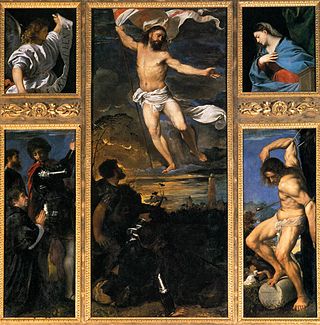
The Averoldi Polyptych, also known as the Averoldi Altarpiece, is a painting by the Italian Renaissance painter Titian, dating to 1520–1522, in the basilica church of Santi Nazaro e Celso in Brescia, northern Italy.
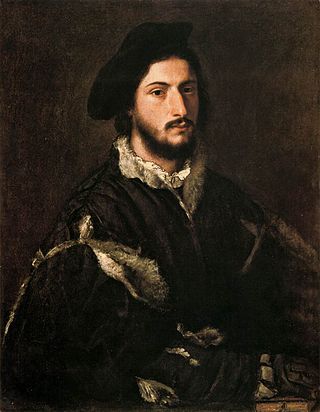
Portrait of Vincenzo Mosti is a painting by Titian, executed around 1520. It is housed in the Galleria Palatina, in Florence.
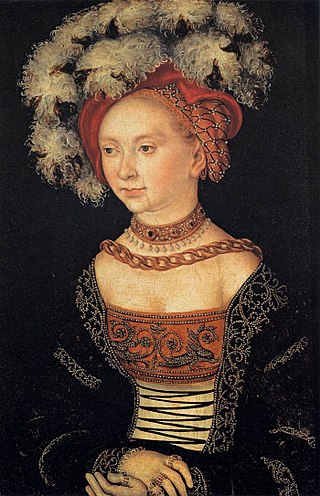
The Female Portrait is a painting by German Renaissance master Lucas Cranach the Elder, dating from around 1530, now housed in the Uffizi Gallery of Florence, Italy.

The Sant'Agostino Altarpiece is a painting by Perugino, produced in two stages between around 1502 and 1512 and then around 1513 to 1523. The altarpiece's 28, 29 or 30 panels were split up during the Napoleonic suppression of religious houses - most of its panels are now in the Galleria Nazionale dell'Umbria in Perugia. It is notable as the painter's last masterwork before he moved into his late phase producing more provincial commissions.

Mary Magdalene is an oil on panel painting of Mary Magdalene, dating to around 1500 and now in the Galleria Palatina in Florence - it has featured in its inventory since 1641. It is now attributed to Perugino. It is modelled on his wife Chiara Fancelli, who also modelled for several of his Madonnas. It is comparable to his Madonna and Child with St John the Baptist and St Catherine of Alexandria (Louvre), of similar date and with a similar dark background.

Portrait of a Boy is a 1495 oil on panel portrait, now in the Uffizi in Florence. In the past it has been attributed to Lorenzo di Credi, Viti, Jacopo Francia, Raphael and others, but Giovanni Morelli's reattribution of it to Perugino is now widely accepted. Although the lack of a landscape background is unusual for this painter, the style is typical of his portrait technique.

Saint Jerome in His Study is a c. 1445–1446 painting by Colantonio, a painter active in Naples between 1440 and around 1470. It shows the strong influence of contemporary Flemish and French art on the painter and originally formed part of a multi-panel altarpiece for the church of San Lorenzo Maggiore, later split up. The painting's dimensions are 151 centimetres (59 in) by 178 centimetres (70 in).

Adoration of the Shepherds is a c.1534 oil-on-canvas painting by the Italian Renaissance artist Lorenzo Lotto, signed "Lottus" and now in the Pinacoteca Tosio Martinengo in Brescia. Its dating is based on stylistic motifs such as the naturalistic details similar to those of the Recanati Annunciation. It also shows similarities to nativities painted around the same time by Girolamo Savoldo, whom Lotto met in Venice. It seems to have been commissioned by Braccio II and Sforza Baglioni, two noblemen from Perugia, who were the models for the two shepherds. They may have met the artist in the Marche during a pilgrimage to Loreto. A ring on Mary's right hand is probably an allusion to the Holy Ring, a relic in Perugia Cathedral, which supports the idea that the work was produced for that city. This provenance is solely based on an account from 1824 by the art dealer who that year sold it to Paolo Tosio, a count from Brescia.

Il Tramonto (The Sunset) is an oil on canvas landscape painting by Giorgione, created c. 1505–1508, now in the National Gallery, London, which bought it in 1961.

Portrait of a Young Flautist or The Flute Player is an oil on canvas painting by Giovanni Girolamo Savoldo, created c. 1540, now in the Pinacoteca Tosio Martinengo in Brescia.

The San Domenico di Pesaro Altarpiece is an oil-on-panel painting created ca. 1524–1526 by the Italian Renaissance artist Giovanni Girolamo Savoldo, now in the Pinacoteca di Brera, in Milan. The work dates to the same period as Savoldo's Rest on the Flight into Egypt, also produced for San Domenico. It shows the Madonna and Child seated between two angel musicians, while in the lower register it shows Saint Peter, Saint Dominic, Saint Paul and Saint Jerome.

Madonna of the Rose Garden is an oil painting on panel of c. 1510 by the Italian Renaissance artist Bernardino Luini. It is in the Pinacoteca di Brera in Milan, which acquired it from the Giuseppe Bianchi collection in 1826.
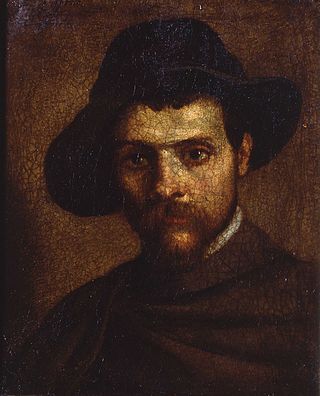
Self-Portrait is a 1593 oil on canvas painting by Annibale Carracci, now in the Galleria Nazionale di Parma. It is dated 17 April 1593 on the top left of the canvas.

Pietà with Saints Clare, Francis and Mary Magdalene is a 1585 oil on canvas painting by Annibale Carracci, now in the Galleria nazionale di Parma.
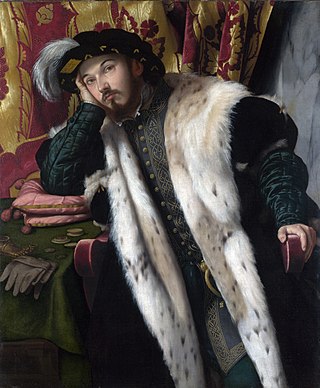
The Bergamasque and Brescian Renaissance is one of the main variations of Renaissance art in Italy. The importance of the two cities on the art scene only expanded from the 16th century onward, when foreign and local artists gave rise to an original synthesis of Lombard and Venetian modes, due in part to the two cities' particular geographical position: the last outpost of the Serenissima on the mainland for Bergamo and a disputed territory between Milan and Venice for Brescia.




















